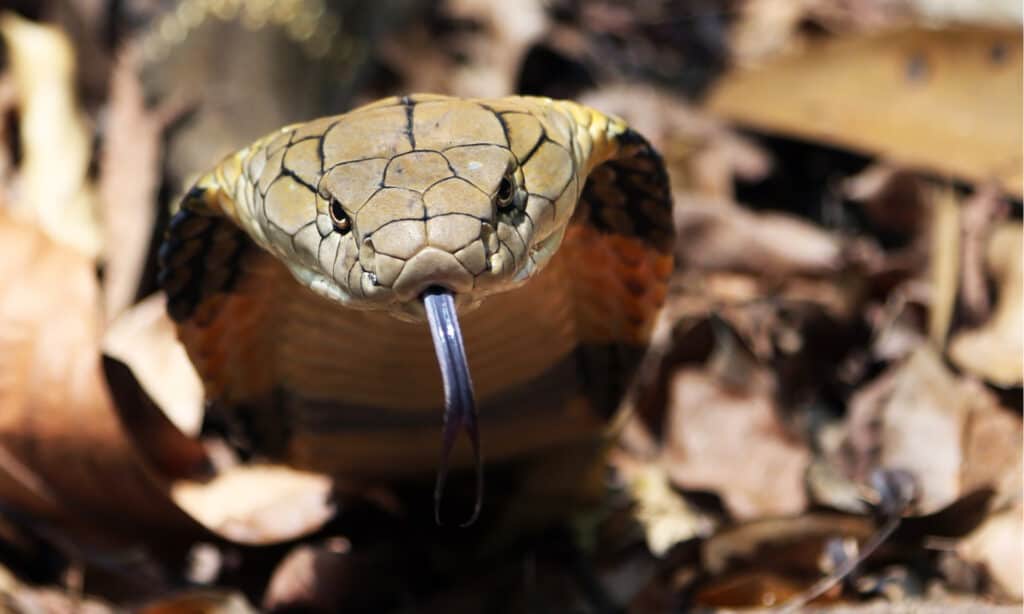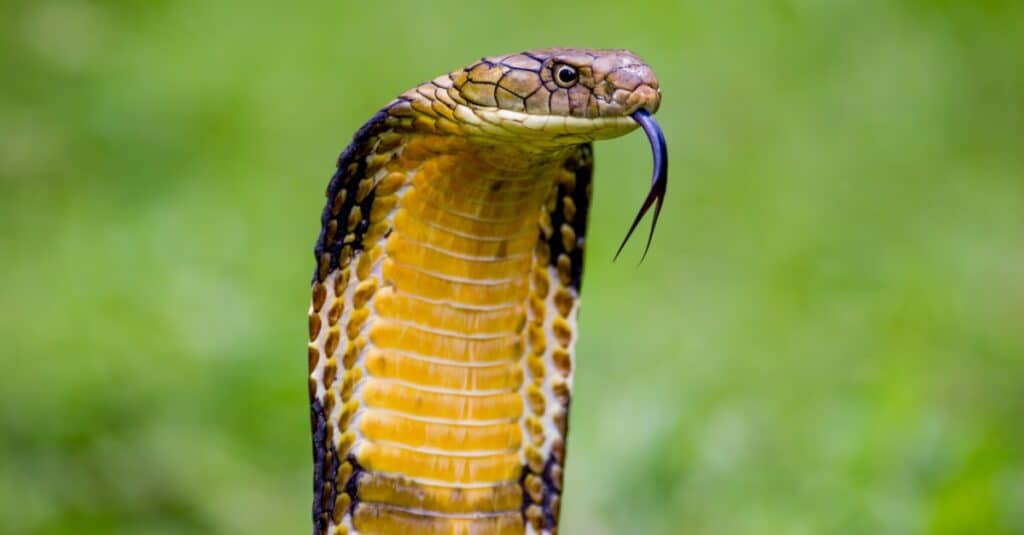Introduction
Both tigers and king cobras are fearsome predators, able to attack and kill prey larger than themselves. While tigers rely on their hunting skills, strength, and bite force, king cobras must use their striking ability and venom to take down prey. In addition, these two creatures can be found in the same region, meaning a confrontation between them could occur. Discover whether a king cobra or tiger would win in a fight and find out the dangers they pose to human life.

King cobras release a highly potent venom that can kill large animals, but will it be enough to take down one of the greatest predators in the world? Find out if the tiger falls victim to the king cobra.
©Suresh Suryasree/Shutterstock.com
Background on King Cobras
The king cobra may also be called hamadryad, and this snake is the largest venomous snake on Earth. The term “hamadryad” derives from the Greek language and translates to “wood nymph.” King cobras reside in South and Southeast Asia, including countries like India, and throughout islands like the Philippines. The habitat of king cobras includes forests and some open fields. They may also make their way into small villages in search of prey.
King Cobra Appearance
The king cobra averages a length of 12 feet, but it may achieve lengths up to 18 feet. The snake also averages a weight of about 13 pounds. In addition, this snake has 11 scales on its head, distinguishing it from other cobra species. Moreover, the coloration of king cobras may appear green, brown, black, or yellow. Adults may also have some designs on their scales, appearing white or yellow.
However, juvenile king cobras typically only appear black with white or yellow stripes. Over time, these markings may fade, and juveniles may develop a new coloration. In addition, king cobra fangs measure around 0.6 inches long, and these fangs release highly potent venom into victims. These snakes also feature a hood encompassing a portion of their neck below their head.

King cobras are the longest venomous snake in the world, measuring up to 18 feet in length!
©RealityImages/Shutterstock.com
How do King Cobras Capture Prey?
King cobras primarily feed on other snake species, including pythons, Indian cobras, members of their own species, and more. They may also eat rodents, birds, and lizards. King cobras hunt during night or day, and they rely on their sense of smell to detect prey.
When a king cobra attacks prey, it strikes quickly and injects venom into prey. This cobra can swallow prey whole after dragging it toward them with their jaws. When king cobras go after small prey, they will likely grow hungry soon after. However, if these snakes conquer prey larger than themselves, they can last weeks without food.
Dangers of King Cobras
King cobras usually do not show aggression toward humans. In fact, king cobra attacks on humans are infrequent, and these snakes usually avoid humans. However, king cobras show the highest levels of aggression when they feel provoked or during mating season. If a king cobra feels threatened by a human, it will lift its head off the ground, looking as though half of its body is standing up. Then, it expands its hood and begins to hiss.
When a king cobra strikes, it delivers potent venom strong enough to kill an elephant. The king cobra releases a copious amount of venom upon striking, more than almost every other venomous snake in the world. In fact, one king cobra bite may deliver between 400 and 500 milligrams of venom.
Moreover, king cobra venom possesses many toxins that break down human bodily functions, including those related to the lungs and heart. Some effects of a king cobra bite include difficulty breathing, heart attack, trouble swallowing, and extreme pain. While king cobras typically shy away from conflict, they certainly know how to defend themselves.

King cobras may release between 400 and 500 mg of venom when they strike prey.
©iStock.com/takeo1775
Threats to King Cobras
Predators of the king cobra include secretary birds, mongooses, and honey badgers. While these predators pose a danger to the king cobra, they are not the largest threats. In fact, the king cobra’s biggest threat is humans. Humans hunt and kill king cobras, as their body parts can be incorporated into medicine, leather, and foods. In addition, some humans keep king cobras as pets or sell them illegally to buyers.
Another threat that endangers king cobras is habitat loss. Climate change, deforestation, and construction often result in habitat loss for many species. Habitat loss forces animals like the king cobra from their habitats. They may struggle to find a new home or discover prey. Therefore, habitat loss can greatly affect king cobra behavior, environment, and feeding, resulting in decreased population numbers. In fact, king cobras are listed as vulnerable for their conservation status.
Background on Tigers
Did you know that tigers are the largest cats on Earth? These extremely ferocious animals live throughout Asia in countries like Russia, China, North Korea, India, and more. The habitat of the tiger primarily includes grasslands, savannas, rainforests, and some cold regions that experience snowfall.
In addition, various tiger subspecies exist throughout their range. For instance, the Siberian tiger is the largest subspecies, but it isn’t the most prominent. Rather, the Bengal tiger boasts higher population numbers than the Siberian tiger. Furthermore, tigers are considered endangered in most parts of the world.

Siberian
tigers are the largest type of tiger, weighing up to 660 pounds!
©Jan Stria/Shutterstock.com
Tiger Appearance
A tiger’s appearance depends on what kind of tiger it is. For example, Bengal tigers measure around 7.2 feet long and weigh between 350 and 500 pounds. On the other hand, Siberian tigers attain a maximum length of 13 feet and may weigh up to 660 pounds.
Most tigers, such as Sumatran or Indo-Chinese tigers appear orange or tan with black stripes and a white underbelly. Siberian tigers usually show a paler coloration, and their fur is longer. However, some tigers, such as white tigers, show a white coloration with black stripes. Moreover, black tigers also exist, but these creatures are rare encounters.
How Do Tigers Capture Prey?
Examples of prey of tigers include water buffalo, deer, antelope, wild boars, and elephant calves. However, the diet of tigers is broad, and they may choose to consume other animals, too. In addition, different tiger subspecies may prefer different foods.
When a tiger hunts, it uses its senses of hearing and sight as guides. Then, tigers typically stalk prey, gradually growing nearer to their victim. When a tiger strikes prey, it jumps on it quickly, usually biting the neck of the prey immediately. One interesting fact about tigers is that they can eat up to nearly 90 pounds of meat at a time.

Tigers may attack and kill antelope for food.
©iStock.com/Kyslynskyy
Dangers of Tigers
Tigers do not hunt humans for food, but the animal remains extremely dangerous to human life. For one, tigers possess several attributes that make them fearsome predators. Tiger claws may measure up to four inches in length, and their teeth may attain a length between 2.5 and three inches. In addition, the bite force of the tiger measures around 1,050 PSI, which is nearly twice the bite force of a lion at 650 PSI.
Tigers will attack humans if they feel threatened or have been provoked. However, some rare cases of unprovoked tiger attacks on humans have occurred. In addition, many tiger attacks have occurred in zoos or sanctuaries, where tigers are held instead of living in the wild. For instance, a Bengal tiger attacked and killed a zookeeper in Chile in 2021, and this instance is just one of many examples of captive tiger attacks on humans.
Threats to Tigers
Adult tigers have no natural predators, but cubs are vulnerable to predators like snakes, hyenas, and crocodiles. Overall, the tiger’s biggest threat is humans. Poaching remains one of the largest threats to tiger populations. Some people illegally hunt tigers and sell their fur to buyers. In addition, humans may defensively kill tigers if these predators begin to target their livestock. Like the king cobra, tigers also suffer from habitat loss, and the tiger is listed as an endangered species.
Furthermore, captivity also threatens tigers. Estimates show that around 5,000 tigers are kept in captivity in the United States alone. By comparison, just under around 4,000 tigers exist in the wild throughout their native range. Captivity can take a toll on any creature, and these apex predators may struggle more than small, docile animals while captive. In fact, some tigers in captivity have attacked their keepers or owners. While big cat captivity is still an issue of hot debate, it’s important to recognize how captivity affects tiger behavior, mood, appetite, and lifestyle.

Approximately 5,000 tigers are kept captive in the United States.
©Pierre Aden/Shutterstock.com
King Cobra vs. Tiger: A Comparison
| Characteristics | King Cobra | Tiger |
|---|---|---|
| Size | 12 to 18 feet long | 7 to 13 feet long |
| Weight | 13 pounds | 350 to 660 pounds |
| Features | 11 scales on the head, hood, venom, and fangs | Orange or white with black stripes, powerful bite, strong, and largest cat. |
| Dangers | Fangs, venom, and strike force | Bite force, claws, teeth, strength, and hunting skill |
| Threats | Hunting and habitat loss | Poaching and habitat loss |
| Predators | Secretary birds, mongooses, and honey badgers | None (cubs susceptible to predation) |
| Prey | Snakes, rodents, birds, and lizards | Wild boars, elephant calves, antelope, water buffalo, deer, and more. |
| Habitat | Forests and fields | Rainforests, savannas, grasslands, and some cold regions |
| Dangerous to Humans? | Sometimes | Yes |
| Conservation Status | Vulnerable | Endangered |
Which Animal Would Win in a Fight: King Cobra or Tiger?
In an epic battle between a king cobra and a tiger, the tiger would emerge victorious. While king cobras have taken down massive animals, such as elephants, in the past, a king cobra would be no match for a tiger. If the tiger were a cub, the king cobra could likely overcome it. Assuming that the fight is between an adult tiger and an adult king cobra, though, the tiger’s predatory features would beat the king cobra.
In one battle scenario, the tiger could sneak up on the cobra and take it down with one bite. This fight would be quick and easy, finished in no time. However, if the king cobra were to make the first strike on the tiger, the tiger could have trouble defending itself. King cobras deliver their venom in high quantities, so the tiger might begin to feel its effects early on. Nevertheless, the tiger could still fight off the king cobra despite its injury, killing the snake before it has a chance to strike again.

The tiger is crowned the winner of this fight due to its strength, predatory instincts, bite force, and menacing features.
©Ondrej Prosicky/Shutterstock.com
Discover the "Monster" Snake 5X Bigger than an Anaconda
Every day A-Z Animals sends out some of the most incredible facts in the world from our free newsletter. Want to discover the 10 most beautiful snakes in the world, a "snake island" where you're never more than 3 feet from danger, or a "monster" snake 5X larger than an anaconda? Then sign up right now and you'll start receiving our daily newsletter absolutely free.
Thank you for reading! Have some feedback for us? Contact the AZ Animals editorial team.








